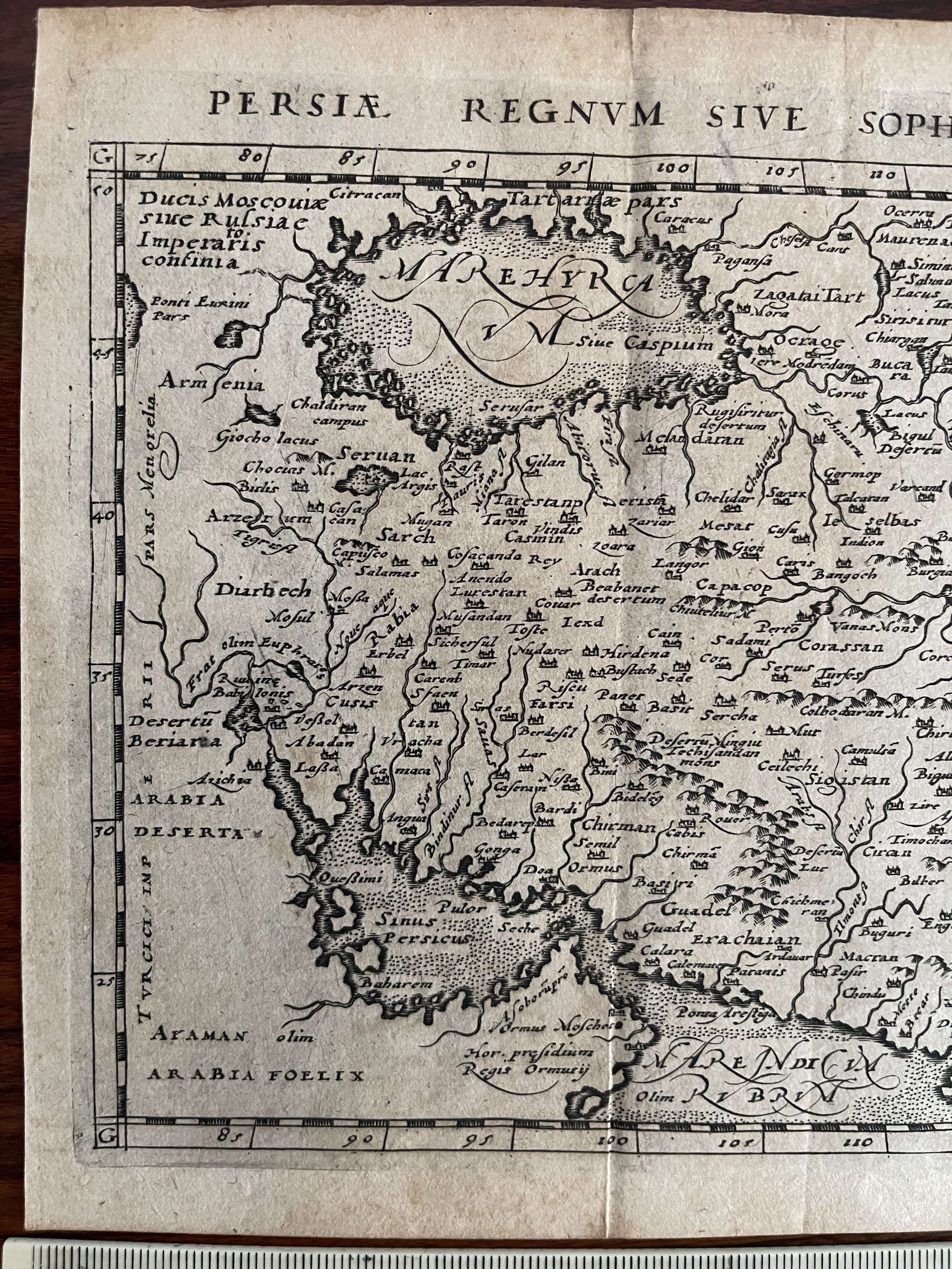Persia - Persiae Regnum sive Sophorum Imperium - Giovanni Magini / Petrus Keschedt Venice - 1596
Antique miniature map Persia Regnum sive Sophorum . Striking example of Magini's map of the the Kingdom of Persia, from an early edition of Magini's Geographiae Universae tum Veteris tum Novae Absolutissimum. Giovanni Antonio Magini was an accomplished Italian cartographer, astronomer, astrologer, and mathematician—in short, a Renaissance man. Born in Padua, he studied philosophy in Bologna. His first publication was Ephemerides coelestium motuum, an astronomical treatise published in 1582. In 1588 he was selected, over Galileo Galilei, to fill the chair of mathematics at the University of Bologna. He died in that city in 1617.
Magini operated under a geocentric understanding of the universe and created his own planetary theory consisting of eleven rotating spheres. He published this theory in Novæ cœlestium orbium theoricæ congruentes cum observationibus N. Copernici (Venice, 1589). In the 1590s he published works on surveying and trigonometry, as well as invented a calculator. In 1596, he published a commentary of Ptolemy’s Geographia, which was published in several editions and languages. He labored for years on an atlas of Italy, which was printed posthumously in 1620. To pay for this project, Magini served as the math tutor to the son of the Duke of Mantua, as well as being the court astrologer to the Duke.DESCRIPTION: A fine early map of the Persian Empire. This map appeared in Magini's "Geographiae Universae...". Engraved by the Italian master enngraver Girolamo Porro. Several sea monsters are shown in the surrounding waters. Magini was an Italian professor of astronomy who also studied medicine, mathematics and philosophy. He was in contact with many well known figures of the day including, Johannes Kepler, Galileo and Tycho Brahe. His most important work was his first printed atlas of Italy, which was published after his death by his son Fabio.
Antique miniature map Persia Regnum sive Sophorum . Striking example of Magini's map of the the Kingdom of Persia, from an early edition of Magini's Geographiae Universae tum Veteris tum Novae Absolutissimum. Giovanni Antonio Magini was an accomplished Italian cartographer, astronomer, astrologer, and mathematician—in short, a Renaissance man. Born in Padua, he studied philosophy in Bologna. His first publication was Ephemerides coelestium motuum, an astronomical treatise published in 1582. In 1588 he was selected, over Galileo Galilei, to fill the chair of mathematics at the University of Bologna. He died in that city in 1617.
Magini operated under a geocentric understanding of the universe and created his own planetary theory consisting of eleven rotating spheres. He published this theory in Novæ cœlestium orbium theoricæ congruentes cum observationibus N. Copernici (Venice, 1589). In the 1590s he published works on surveying and trigonometry, as well as invented a calculator. In 1596, he published a commentary of Ptolemy’s Geographia, which was published in several editions and languages. He labored for years on an atlas of Italy, which was printed posthumously in 1620. To pay for this project, Magini served as the math tutor to the son of the Duke of Mantua, as well as being the court astrologer to the Duke.DESCRIPTION: A fine early map of the Persian Empire. This map appeared in Magini's "Geographiae Universae...". Engraved by the Italian master enngraver Girolamo Porro. Several sea monsters are shown in the surrounding waters. Magini was an Italian professor of astronomy who also studied medicine, mathematics and philosophy. He was in contact with many well known figures of the day including, Johannes Kepler, Galileo and Tycho Brahe. His most important work was his first printed atlas of Italy, which was published after his death by his son Fabio.
Antique miniature map Persia Regnum sive Sophorum . Striking example of Magini's map of the the Kingdom of Persia, from an early edition of Magini's Geographiae Universae tum Veteris tum Novae Absolutissimum. Giovanni Antonio Magini was an accomplished Italian cartographer, astronomer, astrologer, and mathematician—in short, a Renaissance man. Born in Padua, he studied philosophy in Bologna. His first publication was Ephemerides coelestium motuum, an astronomical treatise published in 1582. In 1588 he was selected, over Galileo Galilei, to fill the chair of mathematics at the University of Bologna. He died in that city in 1617.
Magini operated under a geocentric understanding of the universe and created his own planetary theory consisting of eleven rotating spheres. He published this theory in Novæ cœlestium orbium theoricæ congruentes cum observationibus N. Copernici (Venice, 1589). In the 1590s he published works on surveying and trigonometry, as well as invented a calculator. In 1596, he published a commentary of Ptolemy’s Geographia, which was published in several editions and languages. He labored for years on an atlas of Italy, which was printed posthumously in 1620. To pay for this project, Magini served as the math tutor to the son of the Duke of Mantua, as well as being the court astrologer to the Duke.DESCRIPTION: A fine early map of the Persian Empire. This map appeared in Magini's "Geographiae Universae...". Engraved by the Italian master enngraver Girolamo Porro. Several sea monsters are shown in the surrounding waters. Magini was an Italian professor of astronomy who also studied medicine, mathematics and philosophy. He was in contact with many well known figures of the day including, Johannes Kepler, Galileo and Tycho Brahe. His most important work was his first printed atlas of Italy, which was published after his death by his son Fabio.
Code : A166
Cartographer : Cartographer / Engraver / Publisher: Giovanni Magini / Petrus Keschedt Venice
Date : Publication Place / Date - 1596
Size : Sheet size: Image Size: 19 x 15 cm
Availability : Available
Type - Genuine - Antique
Grading A-
Where Applicable - Folds as issued. Light box photo shows the folio leaf centre margin hinge ‘glue’, this is not visible otherwise.
Tracked postage, in casement. Please contact me for postal quotation outside of the UK.




